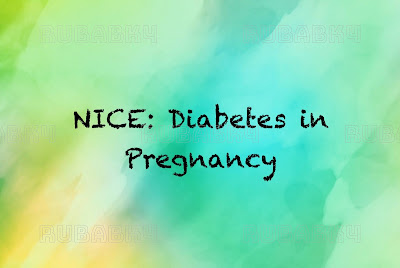This post is a summary of NICE guideline NG23 “Diabetes in Pregnancy” which was published in 2015. This guideline contains recommendations for managing diabetes & its complications in women who are planning pregnancy /already pregnant.
This is one of ‘the must’ guideline for the MRCOG exams. I have extracted only the main points. It is recommended to read the full guideline to ensure that no important points are missed.
I hope this is helpful. Your feedback and suggestions to improve further posts are welcome.
Thanks
To download full guideline Click Here
To download all NICE guidelines Click Here
INTRODUCTION
- 5% pregnancies are complicated by diabetes
- 87.5% → gestational diabetes
- 7.5% → type1
- 5% → type 2
- Risks to woman & fetus
- Miscarriage, pre-eclampsia & preterm labour are more common with pre-existing diabetes
- Diabetic retinopathy can worsen rapidly during pregnancy
- Stillbirth, congenital malformations, macrosomia, birth injury, perinatal mortality & postnatal adaptation problems are more common in babies born to women with pre-existing diabetes
PRECONCEPTION PLANNING AND CARE
- Good blood glucose control before conception & continuing it throughout pregnancy reduces the risk of miscarriage, congenital malformation, stillbirth & neonatal death
- Risks can be reduced but not eliminated
- Important to avoid unplanned pregnancies & effective contraception
- Provide information about how diabetes affects pregnancy and how pregnancy affects diabetes
- Make sure woman enters pregnancy in best optimum health in order to avoid complications
- BMI ≥27 offer advice on weight loss
- Prescribe folic acid 5 mg/day to reduce risk of baby with neural tube defects
Monitoring of blood glucose & ketones in the preconception period
- Offer monthly HbA1c to those diabetics planning to become pregnant
- Teach self-monitoring of blood sugar levels& use of glucometer
Target blood glucose and HbA1c levels
- Aim for same capillary plasma glucose target ranges as recommended for all people with type 1 diabetes
- Aim to keep HbA1c levels below 48 mmol/mol (6.5%)
- Advise against pregnancy if HbA1c level above 86 mmol/mol (10%)
Safety of medicine for diabetes before and during pregnancy
- Metformin can be used
- All other oral blood glucose-lowering agents should be discontinued before pregnancy & insulin substituted






